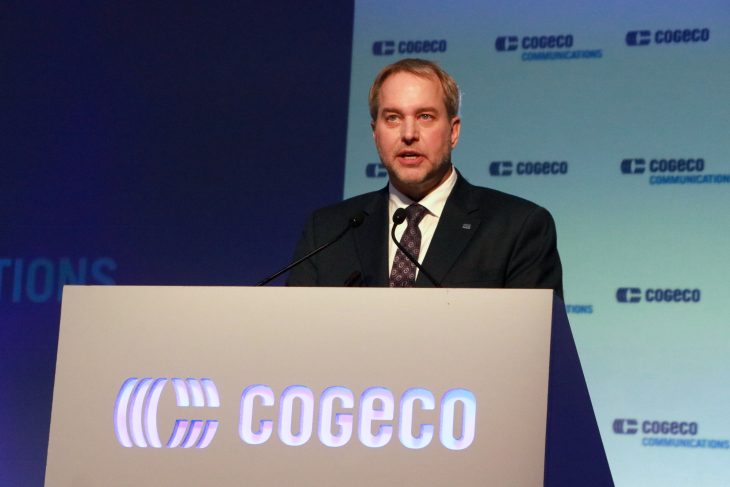
By Ahmad Hathout
MONTREAL – With less than a month remaining to get an agreement hammered before the CRTC-imposed deadline, Cogeco CEO Philippe Jette said the telecom is still working to get a deal done to roam on the large carriers’ wireless networks.
“We’re still determined to launch a mobile service in Canada and we are now in negotiations with the MNO,” Jette said on the company’s fiscal third-quarter conference call with analysts Friday. “For competitive reasons, we won’t go further on this call…it remains a critical element for our business case to enter for the long-term this market, so we are expecting to close these negotiations in line with our aspirations but we’re into it right now. So more to come in the next quarter.”
The CRTC in May set August 7 as the deadline for mobile network operators – that is, the large national carriers – to complete negotiations with these regional mobile virtual network operators on access to those wireless networks.
Cogeco said it has already set up a wireless team to work on the backend as negotiations roll forward. Addressing how long it would take to launch following a deal close, Jette said there is some technical interconnection work that will need to be done depending on what the telecom can negotiate. In other words, there is no definitive timeline the company can provide.
“Let’s first get to August 7,” Jette said. “Hopefully we will have closed. If not, we will work with the CRTC with the arbitration process.”
Last month, the CRTC asked the carriers to update it on the status of those negotiations.
So far, Quebecor has complained about a lack of movement, while its subsidiary Videotron is currently in final offer arbitration – the regulatory backstop when commercial negotiations fail – with Rogers. Videotron recently registered with the CRTC as an MVNO.
This quarter, Cogeco said it purchased slices of spectrum in the 2500 and 3500 MHz bands – midband crucial for 5G services – from another licencee for $60 million.
Jette had previously said that the company is taking a financially careful approach to its entry into the mobile wireless market. As such, he has said the rates for access are critical.
“It will be a combination of the spectrum we can acquire,” Jette said. “It will be also the combination of different partnerships of the MVNO framework, so for the next seven years we don’t need to have all the spectrum in every territory. Right now we cover 95 per cent of our operating footprint where we have fibre backbone to evolve a wireless operation.
“So we’re starting with an MVNO operation, and as time progresses we will accumulate the assets that we need and/or the partnerships that we need to continue expanding,” he added.
With the deal deadline coming up and a seven-year deadline in which the regional providers will need to figure out a long-term wireless business before the regime sunsets, Jette said one possible option for the CRTC is to simply extend the regime a little longer.
He said he doesn’t expect that to happen right now, as the CRTC is likely to see how things go now. Jette also raised existing network-sharing agreements as another option to give the regionals some more time to have a fully-function business passed the seven years.
Cogeco reported a 1.7 per cent increase in combined revenue to $767.6 million (in Canadian dollars) for the three months that ended May 31. Because the company has an American broadband business called Breezeline, it saw a decline of 1.4 per cent in revenue in constant currency.
Profit was down nearly 70 per cent to $33.3 million from $108.4 million (Canadian dollars) in the same quarter last year. The company attributed that to an $88-million charge related to its radio properties, higher financial expense, higher acquisition costs (the telecom purchased the internet business of oxio in March), and the appreciation of the U.S. dollar compared to the Canadian dollar.
Cogeco was one of several companies with media properties asking for relief from regulatory spending obligations imposed by the CRTC as they navigate a particularly tough advertising market.
For the quarter, the company added 11,144 internet customers, compared to an addition of just 2,893 in the same quarter last year. The total internet base is 840,662. It attributed that to expanding fibre to premises and absorbing customers from the oxio acquisition. The company continues to see an increase in homes passed with its fibre.
It also lost fewer video customers this quarter (3,790) compared to the 6,357 in the comparable period, for a total base of 639,920. The losses here were attributed in part to changing habits, inflation, and customers only taking up internet services.
It also lost fewer landline customers this quarter at 1,062 compared to 4,443 last year for a total base of 386,735. It blamed that in part on more people taking of mobile wireless services.
The telecom said, as of the end of the quarter, 65 per cent of its Canadian base are subscribed to two or three of its services together.
Photo of Philippe Jette by Steve Faguy



